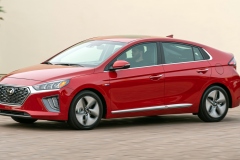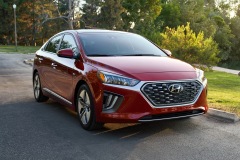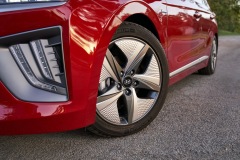High Fuel Economy Choice
The Ioniq liftback is offered in three versions—all electrified, but to varying degrees. It’s either all-electric, a plug-in hybrid or a hybrid.

I tested the EV version last year, but this time I spent a week with the hybrid version. For 2020, in a midcycle freshening, all Ioniq models receive new mesh grilles (or in the case of the EV, a new pattern on the closed panel). It looks a bit more upscale and refined. As the hybrid and plug-in versions are direct competitors with the Toyota Prius, this only makes a stronger case for choosing the Hyundai if you’re cool to the Prius’ extreme styling.

The new model year brings more changes. On the outside, the front and rear bumper fascias are updated. There are new LED head, tail and daytime running lamps, wheel designs and side sill moldings. Like a restyled grille, these are relatively inexpensive updates.
Inside, there’s an optional 10.25-inch widescreen navigation system, new center LCD info screen and changes to the dash and instrument panel, including touchscreen climate controls and high-tech customizable ambient lighting.
The Real Improvement Department
One real improvement impacts only the pure EV version, which is not the subject of this story. It gets a larger battery, so range increases from 124 to 170 miles. That’s significant.

Back to the hybrid. My Summit Gray test vehicle was pleasant to look at, but hardly stood out in the parking lot. It was the top-level Limited model, so it came with the optional wide info screen, a nice Harmon Kardon premium audio system, Smart Cruise Control, an electronic parking brake and more. You can order up a hybrid starting with the Blue super-efficient model, moving up through SE and SEL to hit Limited. Prices run from $23,000 for the Blue to $31,000 for the Limited, not including shipping, so you can choose the one that suits you for budget and features.
Living with a hybrid is the easiest form of electrified motoring. You never have to plug it in because the system gets its electricity from regenerative braking. You can adjust the amount of it when you select Eco mode in the drive selector (you can choose Sport or Normal, too).
The Power Numbers
The 2020 Hyundai Ioniq Hybrid’s 1.6-liter four-cylinder gasoline engine puts out 104 horsepower and 109 pound-feet (lb.-ft.) of torque and is matched up with a permanent magnet 32-kilowatt electric motor with maximum torque of 125 lb.-ft. That really helps move the 3,115-pound hybrid along when you press the accelerator. The motor is powered by a small lithium-ion polymer battery with 1.56 kilowatt-hour of capacity, which sits out of the way under the rear seats, allowing the hybrid to offer 3.5 cubic feet more cargo room than the plug-in or the EV.

This drivetrain gets an official 55 mpg city and 54 highway, which comes out in the EPA’s math to 55 mpg combined. I averaged 39.8 mpg over 126.7 miles of testing. This is significantly below 55, but on one freeway trip I was generating more than 47 mpg, so I think that your average could be closer to 55 over time. This is still way better than a non-hybrid. EPA Green Scores are a good—7 for Smog and a perfect 10 for Greenhouse Gas.
The 2020 Hyundai Ioniq Hybrid may be the perfect car to drive if you just want a pleasant and fairly green way to take yourself and your family where you need to go. It’s attractive, but not distracting. Everything looks and feels good and substantial. I thought my car’s gray on gray interior was a little boring, but I’m not a gray enthusiast. Hyundai likes brushed nickel finishes on the handles and switchgear, which is a nice change from the plastic chrome on other cars.
Safety Tech
The Ionic is a safe place to ride. Its SmartSense Safety and Convenience package includes front collision and avoidance assist with pedestrian detection and new cyclist detection ability and driver attention warning. You also get lane keep assist and high beam assist. You can order lane follow assist as an option. These features, along with smart cruise control, not only promote safety and reduce driver fatigue, but are part of the pathway to an eventual self-driving car.

For efficiency, the Eco-Driving Assist System helps improve fuel economy. It even includes a coasting guide that lets the driver know deceleration is imminent so they can slow down using less braking and save a little fuel. Every bit helps.
I recommend driving a hybrid like the 2020 Hyundai Ioniq when you are not able to plug in a car at all. A plug-in hybrid provides some all-electric range, reducing gasoline use while making local trips zero-emission. Pure EVs are great when you have easy access to charging—whether it’s in your garage or your neighborhood. The Ioniq can help you for all three choices.
Make sure to opt-in to the Clean Fleet Report newsletter (top right of page) to be notified of all new stories and vehicle reviews.
Related Stories You Might Enjoy—The Hybrid Sedan Size Options
Compacts
Road Test: 2020 Toyota Prius Hybrid
Road Test: 2019 Honda Insight Hybrid
Road Test: 2020 Toyota Corolla Hybrid
Road Test: 2017 Kia Niro FE Hybrid
Midsize
Road Test: 2019 Toyota Camry Hybrid
Road Test: 2017 Honda Accord Hybrid
Road Test: 2017 Ford Fusion Hybrid
Road Test: 2018 Hyundai Sonata Hybrid
Road Test: 2017 Kia Optima Hybrid
Large
Road Test: 2019 Toyota Avalon Hybrid
Disclosure:
Clean Fleet Report is loaned free test vehicles from automakers to evaluate, typically for a week at a time. Our road tests are based on this one-week drive of a new vehicle. Because of this we don’t address issues such as long-term reliability or total cost of ownership. In addition, we are often invited to manufacturer events highlighting new vehicles or technology. As part of these events we may be offered free transportation, lodging or meals. We do our best to present our unvarnished evaluations of vehicles and news irrespective of these inducements.
Our focus is on vehicles that offer the best fuel economy in their class, which leads us to emphasize electric cars, plug-in hybrids, hybrids and diesels. We also feature those efficient gas-powered vehicles that are among the top mpg vehicles in their class. In addition, we aim to offer reviews and news on advanced technology and the alternative fuel vehicle market. We welcome any feedback from vehicle owners and are dedicated to providing a forum for alternative viewpoints. Please let us know your views at publisher@cleanfleetreport.com.









6 thoughts on “Road Test: 2020 Hyundai Ioniq Hybrid”